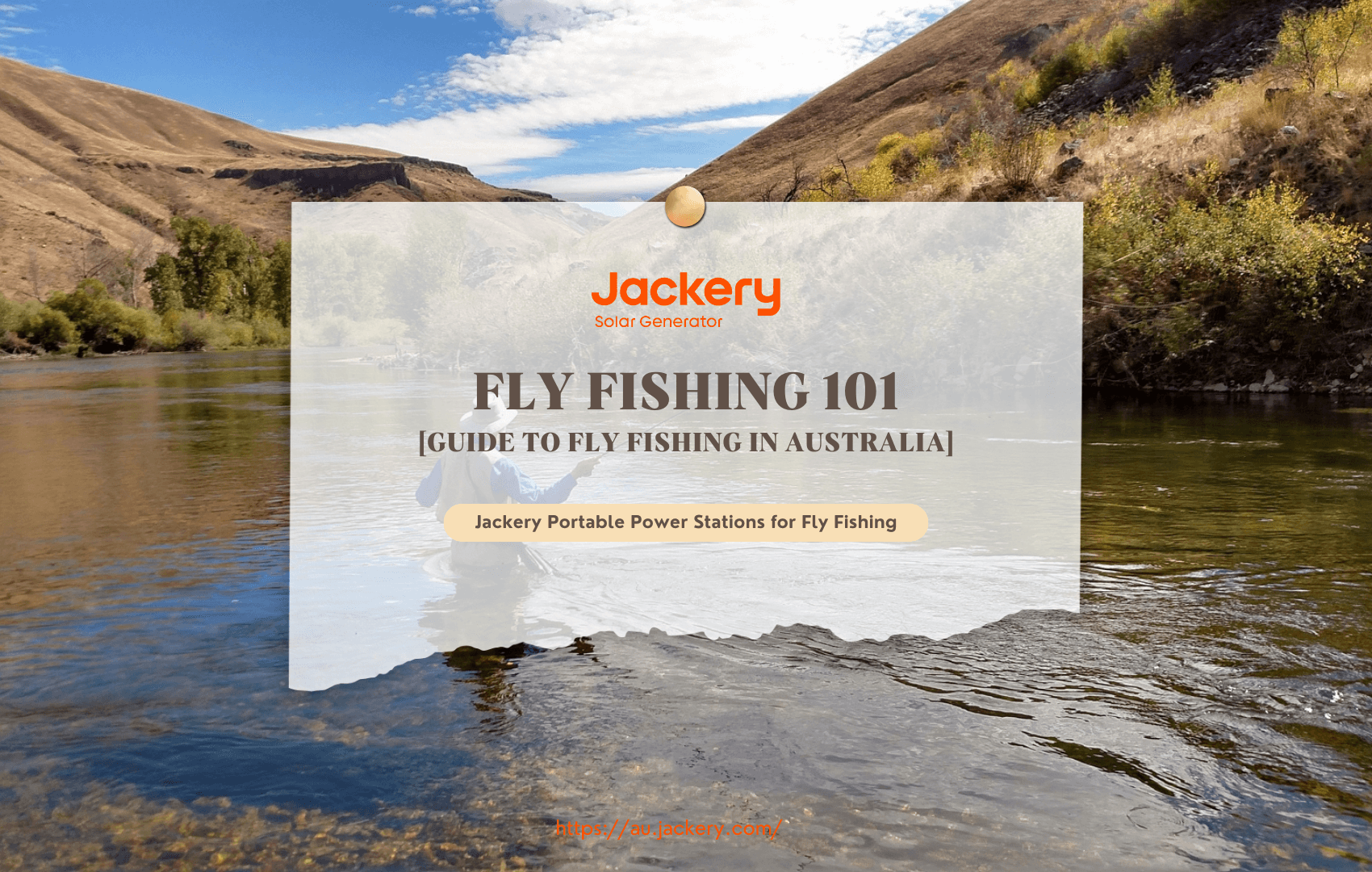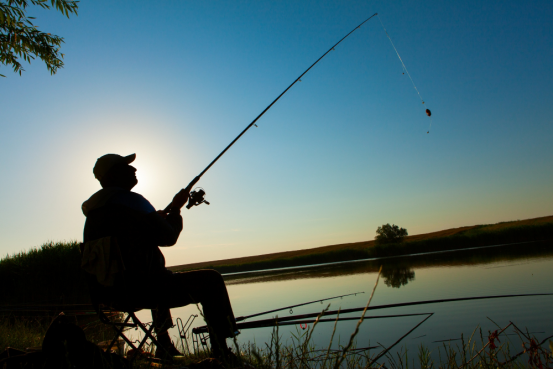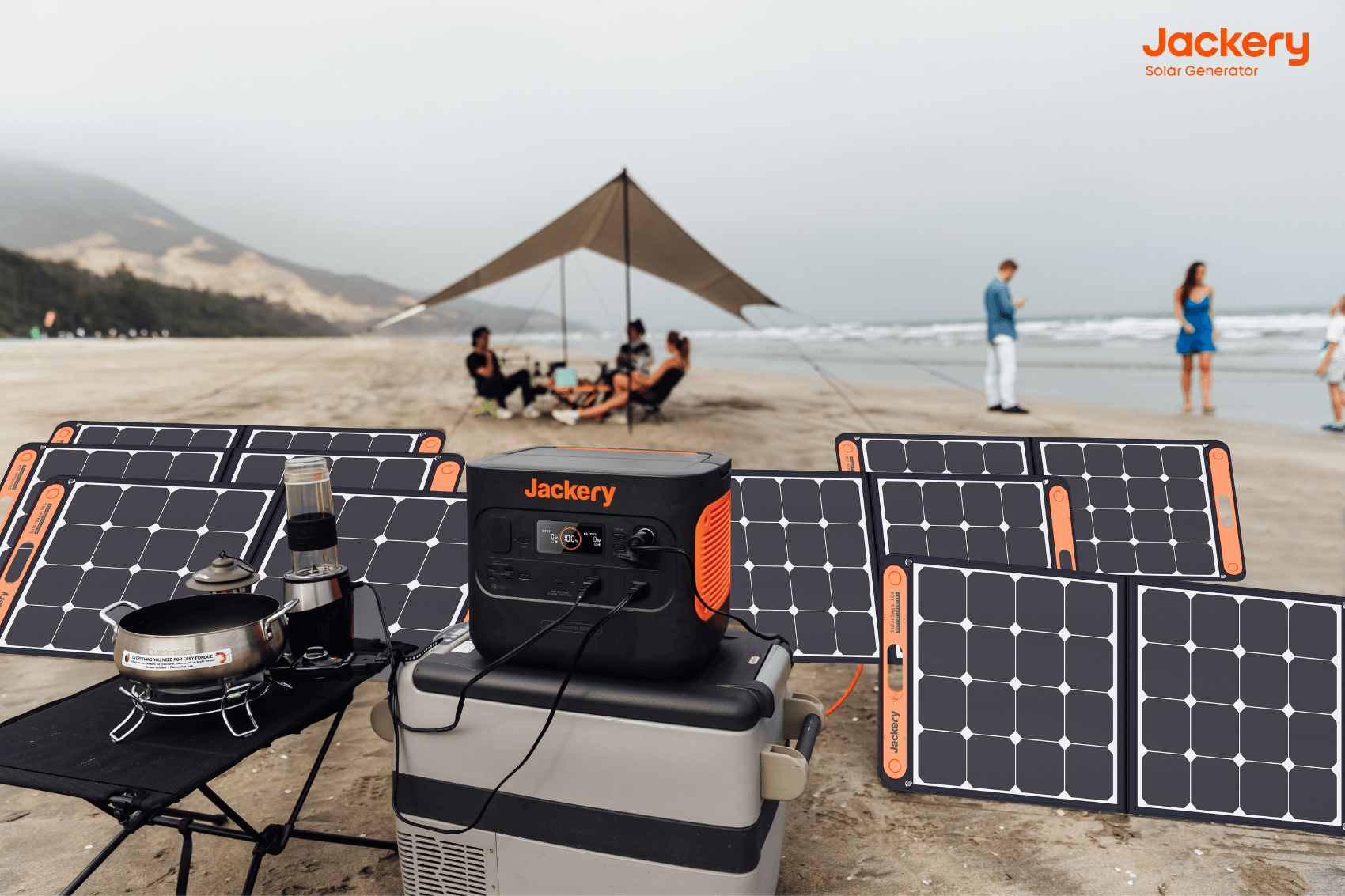|
Key Takeaways: |
|
• Fly fishing is different from other types of fishing because it imitates how insects act in the wild. • Every gear an angler uses is crucial to their success on the water, from carefully made lines and reels to flies. All the fly fishing gear is listed below. • We highly recommend Jackery Explorer 500 and 300 Plus portable power stations to charge your fishing devices if you run out of electricity. • Before going on a fly fishing trip, you must learn how to cast a fly and develop good ways to catch hiding fish. • There are mainly three fly fishing methods: nymphing, throwing streamers, and floating dry flies. |
What Is Fly Fishing in Australia?
Fly fishing is a unique way to fish that involves presenting light fake flies creatively to catch fish.
Fly fishing is different from other types of fishing because it uses the delicate movements of these carefully made flies to imitate how insects act in the wild. Anglers use this method to get fish to bite, which requires skill and accuracy to mimic the subtle movements of insects skimming the water's surface.
The connection between the fisherman and the fish is a big part of fly fishing. Each cast is like a delicate dance of skill and anticipation. Fly fishermen carefully choose flies that match the hatch, which is the current group of insects in the water, so they can trick fish with imitations that look real.
Anglers try to get their flies to the right place at the right time by using special casting techniques like the fly line's graceful loops and the wrist's slight flicks. These techniques are meant to get even the pickiest fish to come up from their depths.
Fly fishing is more than just fishing; it's a search for unity between the fisherman, the fly, and the fish, creating a tapestry of art and connection in the calm waters.
Fly Fishing VS. Traditional Fishing
In traditional fishing, we make a cast by attaching a lure or bait to the end of our line. The line can be a monofilament or one of the later braided types.
One thing you'll notice about this setup is that the hook or bait is heavier than the line, which is very thin and light. With this setup, when you let go of the cast, the hook or bait moves through the air, leaving the light line behind.
If you've ever seen someone fly cast, you'll know it's not the same as standard casting. This cast is made possible by the fisherman's special fly fishing gear. This includes the fly, the fly line, the leader, the tippet, and the fly.
While throwing a fly, the main difference is that fake flies used to catch fish don't have much weight to them. Even when you use much bigger flies to fly fish for bass or pike, they still need to be lighter than throwing a spinning lure or other traditional bait.

Essential Fly Fishing Gear & Equipment
Fly fishing is an exciting, simple, and artistic way to catch fish, but it requires a unique set of gear and equipment to immerse anglers fully in the chase of their fish. Every gear an angler uses is crucial to their success on the water, from carefully made lines and reels to carefully tied flies.
Thinking about how rods, reels, lines, leads, tippets, and flies will work together before you fly fishing is essential. There are different lengths, weights, and actions of fly fishing poles, and each is best for a specific type of fishing and casting style.
When fishermen use an excellent fly reel and the right fly line, they can make accurate throws and get fish to bite on their flies. Leaders and tippets are the unseen links between the fly line and the fly. Different fishing lines are available in various lengths and strengths, allowing you to select the most suitable one based on the type of fish you intend to capture and their behaviour.
The following are the fly fishing gear & equipment:
|
Fly Fishing Gear |
||
|
Fly Fishing Rod |
Fly Fishing Reel |
Waders |
|
Wading Boots |
Fly Line Backing |
Leaders |
|
Tippet |
Flies |
Floatant |
|
Fly Box |
Polarized Sunglasses |
Portable Cooler |
|
Day Pack |
Sun Protection |
Insect Repellent |
|
Camera & Phone |
Flashlight |
Portable Power Station |
Packaging well for a trip is always challenging, and having the right fly-fishing stuff is essential for having fun and success. It is also important to pack efficiently and thoughtfully and leave behind the extraneous gear you will not need. If you want to know more about fishing gear, check here.
One thing you should always remember is a portable power supply to charge your phone, GPS, portable cooler, and other essential tools. You must bring the Jackery Portable Power Station wherever you go: fly fishing, bass fishing, hikes, etc.
Jackery Portable Power Stations for Fly Fishing
We've discussed the importance of a portable power station in a fly fishing trip, especially the Jackery Portable Power Stations. A portable power station has many output ports, such as AC outlets, DC plugs, and USB ports, to charge many devices simultaneously.
The Explorer 500 and 300 Plus from Jackery are the best portable power stations for charging fishing gear. Since they are small and light, you can take them with you to any outdoor activity that doesn't make noise that could make it hard to fish.
|
Phone |
Power Needed |
Working Hours |
|
|
Jackery Explorer 500 |
Jackery Explorer 300 Plus |
||
|
Phone |
5W (5V⎓1A) |
88.06H |
48.96H |
|
Camera |
85W (24V⎓3.6A) |
5.12H |
3.4H |
|
Portable Cooler |
240W (12V⎓20A) |
1.8H |
1.2H |
|
Portable Fan |
20W (5V⎓4A) |
22H |
14.4H |
|
Flashlight |
10W (5V⎓2A) |
44H |
24.5H |
|
Electric Fish Finder |
24W (12V⎓2A) |
18.3H |
12H |
Jackery Explorer 500 Portable Power Station
The Jackery Explorer 500 is the best way to charge electrical gear on a fishing trip, power outdoor appliances in any outdoor adventure, or as a backup power source for your home.
The battery capacity of this power station is a fantastic 518Wh, and it was made with ease of use in mind. It's great for people who want a reliable backup power source for their electronics because the handle can be folded, and the design is comfortable.
The Jackery Explorer 500 has the best BMS (Battery Management System) technology, ensuring it works ideally and is always safe. At only 6.4 kg, its light weight makes it even more portable, making it very easy to take wherever your trip takes you.
The Jackery Explorer 500 portable power station is ready to meet your fishing energy needs; for example, you can charge your phone for 88 hours or your camera for 5 hours. With Jackery Explorer 500 by your side, it's now easier to go on trips.

Jackery Explorer 300 Plus Portable Power Station
The Jackery Explorer 300 portable power station is a small powerhouse that makes charging devices inside and outside easier. This small power station is made for all the energy needs on fishing trips. The battery can hold 288Wh of power and can send out 300W.
The Jackery Explorer 300 portable power station has two PD ports; each can send out up to 100W. It is an open and helpful way to charge because they can quickly charge multiple devices simultaneously. The small size and lightweight make it easy to charge outside, giving you a reliable power source for your trips.
There are different charging options on the Jackery Explorer 300 portable power station, so you can charge your gear anywhere in Australia you fish. A portable cooler can run on it for 1.2 hours, and a small fan can run on it for 14.4 hours. This small power station is powerful and easy to carry, so your devices will always be charged on your fly fishing trips.

Fly Fishing Techniques, Strategies & Tactics
Before going on a fly fishing trip, you must learn how to cast a fly and develop good ways to catch hiding fish. Every cast is a careful move meant to trick fish into biting. It's like a dance between the fisherman and nature.
Fly fishermen have to change how they cast and what they do based on the water conditions and fish species where they are fishing, from quiet mountain streams to busy bays on the coast.
At the heart of fly fishing is a set of casting methods designed for a different type of fishing situation or weather. An angler may use the traditional overhead cast, the subtle roll cast, or the precise sidearm cast to present flies with finesse and precision. To get good at these casting methods, you need to be patient, practice, and know a lot about how rods move and how to control lines. With each cast, anglers try to make the proper presentation to get fish to come up from under the water and strike.
To be good at fly fishing, you must know more than just how to throw the fly. You also need to understand how fish behave and where they like to live. Anglers need to learn to read water currents, figure out when fish are eating, and guess where fish will go next to get in the best position for fishing.
By looking at changes in the surface, the water's structure, and the insects' activity, fishermen can find good fishing spots and adjust their techniques to suit them. It's essential to adapt to changing conditions and fish behaviour to catch rising trout in a calm stream or look into deep holes for predators that might be hiding.
Effective fly fishing techniques are more than just knowing how to cast the fly. They also include a complete understanding of the water and how fish behave. Anglers need to learn how to read the minor signs that nature sends them, like the ripples in the water and the way birds and bugs act.
Angling enthusiasts can learn about fish and enjoy the thrill of the chase by becoming one with the water and its various life forms. Thanks to current technology like Jackery Portable Power Stations, fishermen can stay connected and charged while fishing, giving them the energy to focus on catching their fish.
Fly Fishing Methods
Its distinguishing features are central to fly fishing, chief among them being lightweight flies delicately presented on the water's surface.
Unlike heavy lures or live food used in traditional fishing, flies are carefully made to look like aquatic insects. They are very appealing to fish because they look like the real thing. In Australia, there are three main ways to fly fishing.

- Nymphing
Nymphing is a popular way to fish with a fly. You do it by presenting imitations of aquatic bug nymphs below the surface. Nymphs are usually weighed down, sinking below the water's surface. There, they look like watery insects like mayflies, caddisflies, and stoneflies when they are young. Different methods, such as indicator nymphing, euro nymphing, and tightening, can be used to nymph.
- Throwing Streamers
A lively way to fish with flies is to throw streamers, which are considerable, brightly coloured flies that look like baitfish, leeches, or other significant, watery prey. Different retrieval methods, like stripping, swinging, or jigging, are used by anglers to make the streamer look like it's moving, which attracts bold strikes from predatory fish. When fishing for trout, bass, pike, and musky in both freshwater and ocean, throwing streamers is the best way to catch them.
- Floating Dry Flies
Floating dry flies are a standard way to fish with a fly. You use light flies that float on the water's surface to look like adult insects like mayflies, caddisflies, and stoneflies. Anglers use delicate presentations that look like these bugs moving naturally to get fish to the top. Floating dry flies are often linked to the thrill of sight fishing, where fishermen watch fish feed on the surface and make precise casts to target specific fish.
Where to Go Fly Fishing in Australia?
With its large and varied landscapes, Australia has many great places for fly fishermen to find excitement and peace in the beauty of nature.
Anglers have many options regarding where to throw their lines. Western Australia has rough coastlines, calm rivers in Tasmania, and mountain streams in the Victorian High Country. Check the following best fly fishing spots in Australia:
1. The Murry River
Location: 2.5 hours drive from Melbourne
Phone: 03 5874 2517
Website: Murry River
When to Visit: Late winter and spring
The Murray River flows majestically through the middle of southeast Australia. It is a famous spot for fly fishermen looking for excitement amid stunning natural beauty. As Australia's longest river, the Murray flows through a wide range of landscapes, from rough bushland to lush riverbanks. This gives anglers a wide range of fishing chances and beautiful views.
The Murray River is famous for having a lot of different kinds of fish, like golden perch, Murray cod, and trout. It offers fly fishermen a lot of several types of fishing adventures. Anglers can discover a range of habitats and fishing styles along the river, from the quiet upper reaches in the Victorian Alps to the busy waters near the mouth in South Australia.
The Murray River is a great place to go fishing because it has a lot of natural history. Anglers can enjoy a fishing adventure that shows off Australia's waterways by casting dry flies along the top or streamers into deep pools.
2. Kangaroo Island
Location: 112 km (70 mi) southwest of Adelaide
Phone: 08 8553 4500
Website: Kangaroo Island
When to Visit: December to February
Off the coast of South Australia, Kangaroo Island is a beautiful place for fly fishermen who want to get away from it all and see lots of sea life. Kangaroo Island has rocky shores, stunning beaches, and water that is as clear as glass. It is an excellent place for anglers to explore a wide range of fishing grounds full of different saltwater species.
Kangaroo Island is famous for its beautiful landscapes and clean marine environments. Its beaches are always calling fly fishermen looking for exciting experiences. From the cliffs of Cape Willoughby to the calm bays and estuaries of American River and Vivonne Bay, the island's coastline offers a wide range of fishing options for people of all skill levels.
3. Tiwi Island
Location: 80 km (50 mi) to the north of Darwin adjoining the Timor Sea
Phone: 08 8944 7095
Website: Tiwi Island
When to Visit: May to September
The Tiwi Islands are off the northern coast of Australia. They are a paradise for fly fishermen who want to explore their pristine seas and face new challenges. This remote group of islands, with its two main islands, Bathurst and Melville, gives anglers a unique chance to enjoy pristine nature and world-class fishing in a tropical paradise far from everything else.
The Tiwi Islands are an excellent place for fly fishermen who want an authentic and immersive fishing experience. They are known for their rich Aboriginal culture, beautiful scenery, and great fishing. The marine environments around the islands are very different, with vast flats, mangrove-lined estuaries, deep waterways, and reef systems. These various environments support a lot of other fish species.
Fly Fishing FAQs
The frequently asked questions about fly fishing in Australia are listed below:
- 1. What size of portable power station do I need for fly fishing?
If you need much power, pick a Jackery Portable Power Station that can hold between 300Wh and 12 kWh. If you want to fly fishing, one of the most important things to consider is how much power it has.
The tools and gadgets that a power station can use depend on how much power it has. To find out how many hours of use devices that Jackery Solar Generators power have, do the following:
Working Hours (H) = [Jackery Solar Generator Capacity (Wh)*0.85] / Appliance's Wattage (W)
The Jackery Explorer 500 (518Wh) can supply power to an 85W camera for 5.12 hours (518*0.85/85). Employing this formula makes it straightforward to ascertain which devices will continue functioning.
- 2. Does Australia have good fly fishing?
Over 4,000 kinds of marine life live in Australia. Many are big, mean, and fun to catch with a fly rod. With so many of these species being native to Australia, or "OZ" as the Australians call their home country, Australia is a great place to go fishing all year. There are many saltwater and freshwater fishing spots and other things to enjoy.
- 3. Can you fly fish in Queensland?
For people who love fly fishing, Queensland is a great place to visit. There are always hungry fish in the nearshore seas; you can even try your luck in the bluewater.
Queenfish, weighing between 1 and 15 kilograms, can be found in large numbers in flats and waters near shore. These fish are popular with fly fishermen because they are easy to catch, and there are lots of them. Also on the list are Threadfin Salmon, Permit, Giant Harling, and Golden Trevally, most often found near harbours and bays.
But fly fishing trips aren't just in shallow water. The bravest fishermen went to the islands and out to sea to fight the big fish living there.

(Image Source: Fishing Cairns)
- 4. Can you catch trout in Australia?
Because Australia's temperature and geography are so different, the trout season is different everywhere. Australia's best times to catch trout are usually in the cooler months, from late fall to early spring. This is because that's when the water is warm enough for trout to be active. Or you can learn trout fishing 101 here.
- 5. Who is the famous fly fisherman in Australia?
Joshua Hutchins got his first fish when he was 13. That experience made him want to find the best fly fishing spots worldwide for the rest of his life. He owns the tour company Aussie Fly Fisher and works as a guide, photographer, trip host, and owner.
Final Thoughts
To become good at fly fishing, you must be patient, learn new skills, and love the outdoors. As you know, the techniques and strategies in this guide do not measure success just by how many fish you catch. It's also measured by how much peace and connection you feel with nature along the way.
Also, remember to bring a Jackery Portable Power Station to charge your essential electronics. Take in the trip, enjoy the experience, and let the dance of the fly line lead you to new water adventures.


























































